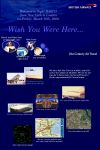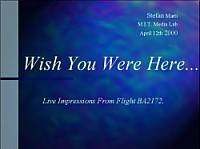This is my entry for the British Airways MIT Media Lab Concorde competition (local copy).

Live Impressions From Flight BA2172
|
Wouldn't it be nice if you could send a postcard to your friends from the cities you are just flying over with your jet plane? Wouldn't it be nice if your family could see where you are, and listen to a video clip of your impressions of the flight? Wouldn't it be nice if you could have a personal photograph album of where you have flown, along with captain's note and your personal note? Wouldn't it be cool if you could show your friends how the control tower saw your plane approaching on the radar screen, and an actual video clip of your landing? Wouldn't it be cool if your friends would ask you "So, what airplane will you fly?" and you just give them the URL of a web page that contains all technical and personal data of your flight, updated live from the airplane? |
|
Traveling with an airplane can be a rather monotonous experience—hours of trying to sleep, watching movies, listening to music, and hours of trying not to think about "We are stuck on the airplane for another five hours!" One of the reasons is that even though they are flying over quite unique places around the world, and even though we are physically traveling such distances, the airplane does not let them feel such activity. The passengers sometimes feel like canned inside the airplane and isolated from the world outside. Wouldn't it be nice if travelers could make more personal connections to the miles they fly? Every flight is unique to the guests, is associated with experiences and memories, and therefore is worth to get documented extensively. Since the Internet is getting more and more the medium where people represent themselves and their experiences, dreams, and hopes, it makes sense to give an important event like a jet flight its own representation in cyberspace. In other words: the flight, this happening, this event, should get expressed on the Web—immediately and live! So why don't we build a unique Web page for each flight, updated live from the airplane with video and audio impressions of the guests and live flight data! One part of this event called flight is related to the airplane as a whole: where is it currently, at which altitude, flying over which city, how is the view through a passenger window, how does the world underneath look like, what does the pilot see, what does that radar picture of flight control show, etc. The other part is what do the guests feel, what do they think. Each flight is personalized with the creative input of the guests. For this purpose, there are several small video and photo booths on the jet, where the travelers can record their impressions, thoughts, and worries. These pictures, sound files, and video snippets are sent immediately to a Web page that contains all possible information of this specific flight. It is like the travelers can send multi media letters to the flight's guest book. The guests can also choose to send their video or photo impressions directly to a specific person, like their family, over the Internet. The web page has the following two functions:
Technically, the following elements are necessary:
| ||||||


